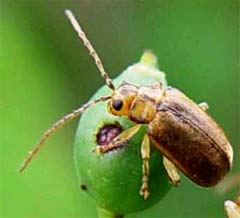According to Cornell University entomologists, the viburnum
leaf beetle, Pyrrhalta viburni, recently introduced into the U.S. from
Europe (by way of Canada), has the potential to become a widespread and
significant pest. The beetle first appeared in 1996 in New York State and has
since turned up in Maine, Pennsylvania, Vermont, and Ohio. It feeds exclusively
and voraciously—in both its larval and adult stages—on viburnums. Susceptible
plants typically die after being attacked for two or three years.
The beetles lay eggs in tiny but visible black-brown rows on
young viburnum branches late in the growing season. Greenish-yellow larvae hatch
early the following spring and grow up to 1/2-inch long. They are able to "skeletonize"
viburnum leaves in a matter of days. In early June, the larvae fall to the
ground and pupate. Adult beetles emerge by early July. They are roughly 1/4-inch
long and brown in color.
Cornell has set up a web page called
Viburnum
Leaf Beetle Citizen Science to collect and disseminate information about the
new pest. It features color photographs of the beetle in all its stages, as well
as distribution maps. It also features pest-management instructions for the
homeowner, including tips on physical (removal of egg-infested twigs),
biological, and chemical control, and advice on planting bug-resistant species
and varieties—and avoiding susceptible ones.
Susceptible Species
Field observations and Cornell laboratory studies have
indicated that the following viburnum species are susceptible to beetle damage:
![]() Gardeners' Corner
Kids'
Garden
Sustainable Garden
Contact Us
Gardeners' Corner
Kids'
Garden
Sustainable Garden
Contact Us![]()


